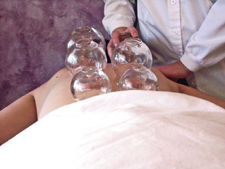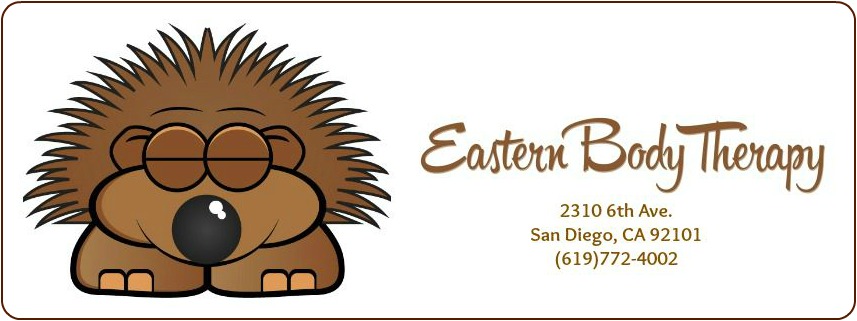What Is Cupping | A Little Suction Please | What's Cupping Like | Poor Pore Pathogens | Print This Page
Cupping is the application of glass or plastic cups on the surface of the skin. Through use of a flame or a suction pump, a vacuum is obtained between the cup and the skin, causing the skin to be sucked up into the cup. Cups are then left in place for a period of time from several minutes to ½ hour or more depending on the condition being treated. Cups may be applied and then left alone, or they may be slid along the surface of the skin to cover a bigger area. back to top

The suction between the cup and the skin causes the muscle and skin to separate slightly, and allows for impurities and cellular waste products in the muscles and fascia (connective tissue) to be drawn towards the skin. In Chinese medicine, the skin is considered to be the surface layer of the body, thus conditions in the skin are considered to be more superficial and less serious than problems deeper in the body. In drawing pathogenic factors out of the muscles and into the skin, the condition is being brought to the surface where it is more easily expelled by the body. The "stuff" being released will appear as a dark, red or purple blotch on the skin in the area where the cup was used.
back to top
The patient can expect to feel some warmth near the skin as the flame is placed into the cup and quickly withdrawn. Then, there is a sensation of something pulling or sucking on the skin. The sensation should be somewhat strong, but not uncomfortable. The practitioner should be notified if there is stinging or burning or if there is any pain. If the sliding cups technique is used, there should be a sensation of the suction sliding up and down the area being cupped. Typically, a small amount of oil is placed on the skin before performing this technique, so the cup is able to glide smoothly without pulling on the skin. After the procedure, the body part which was cupped should be kept covered and protected from wind and sunlight for 24 hours. This is because the pores are opened fully and the body is more susceptible to pathogenic influences after this procedure. The patient may notice redness or a purple to black discoloration of the skin in the area which was treated. This is a normal side effect of cupping, and is considered to be desirable by the practitioner. It should not be painful, despite looking much like a bruise, and should disappear within 3-5 days. back to top

Because cupping draws pathogenic factors to the surface, it is often used for common cold and flu. Consider when you are coming down with a cold. Your neck and shoulders become achy, you may have a headache or sore throat. Your nose may begin to run. The muscle aches you feel are an indication of your body's defensive qi at the surface fighting to keep the pathogen (cold virus) from entering the deeper levels of the body. Cupping on the back, especially between the shoulder blades, loosens up the muscle layers and allows the pathogen to be pulled outward. Cupping at the earliest phases of a common cold may be sufficient treatment to prevent you from becoming sick! Cupping is also used for a variety of muscular conditions resulting in pain. It is useful following a minor sprain or strain to pull stagnated blood from the muscles out to the surface. back to top
|

 Yelp About Us
Yelp About Us 

